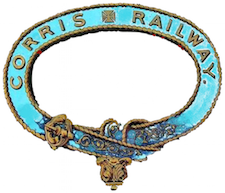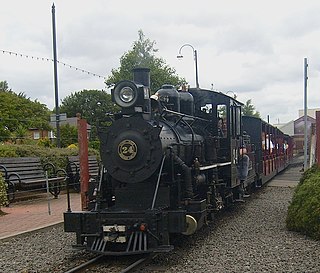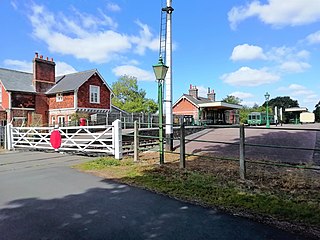
Bristol Temple Meads is the oldest and largest railway station in Bristol, England. It is an important transport hub for public transport in the city. In addition to the train services there are bus services to many parts of the city and surrounding districts, and a ferry to the city centre. Bristol's other major station, Bristol Parkway, is on the northern outskirts of the conurbation.

Wroxham is a village and civil parish in the English county of Norfolk. The civil parish of Wroxham has an area of 6.21 square kilometres and in 2001 had a population of 1532 in 666 households, reducing to a population of 1,502 in 653 households at the 2011 Census. The village is situated within the Norfolk Broads on the south side of a loop in the middle reaches of the River Bure. It lies in an elevated position above the Bure, between Belaugh Broad to the west and Wroxham Broad to the east or south east. Wroxham is some eight miles north-east of Norwich, to which it is linked by the A1151 road. The village and broad lie in an area of fairly intensive agriculture, with areas of wet woodland adjoining the broad and river. For the purposes of local government, the parish falls within the district of Broadland although the river, broad and their immediate environs fall within the executive area of the Broads Authority. On the northern side of the Bure is the village of Hoveton, often confused with Wroxham.

The Bure Valley Railway is a 15 in minimum gauge heritage railway in Norfolk

The South Tynedale Railway is a preserved, 2 ft narrow gauge heritage railway in Northern England and is England's highest narrow gauge railway. The line runs from Alston in Cumbria, up the South Tyne Valley, via Gilderdale, Kirkhaugh and Lintley, across the South Tyne, Gilderdale and Whitley Viaducts to Slaggyford in Northumberland.

The Severn Valley Railway is a heritage railway in Shropshire and Worcestershire, England. The 16-mile (26 km) heritage line runs along the Severn Valley from Bridgnorth to Kidderminster, crossing the Shropshire/Worcestershire border, following the course of the River Severn for much of its route. Train services are hauled predominantly by steam locomotives, plus one diesel hauled train, making two round trips a day, on most days. Diesel locomotives are also used for engineering trains, to replace failed steam locomotives at short notice, and during periods of high fire risk.

The Corris Railway is a narrow gauge preserved railway based in Corris on the border between Merionethshire and Montgomeryshire in Mid-Wales.

The Talyllyn Railway is a narrow gauge preserved railway in Wales running for 7 1⁄4 miles (12 km) from Tywyn on the Mid-Wales coast to Nant Gwernol near the village of Abergynolwyn. The line was opened in 1865 to carry slate from the quarries at Bryn Eglwys to Tywyn, and was the first narrow gauge railway in Britain authorised by Act of Parliament to carry passengers using steam haulage. Despite severe under-investment, the line remained open, and in 1951 it became the first railway in the world to be preserved as a heritage railway by volunteers.

The Narrow Gauge Railway Museum is a purpose-built museum dedicated to narrow-gauge railways situated at the Tywyn Wharf station of the Talyllyn Railway in Tywyn, Gwynedd, Wales.

The 15 in gauge Cleethorpes Coast Light Railway primarily serves holidaymakers in Cleethorpes, North East Lincolnshire, England. It operates from near the Cleethorpes Leisure Centre, running to the mouth of the Buck Beck.

The East Somerset Railway is a 2 1⁄2-mile (4 km) heritage railway in Somerset, running between Cranmore and Mendip Vale. Prior to the Beeching Axe, the railway was once part of the former Cheddar Valley line that ran from Witham to Yatton, meeting the Somerset and Dorset Joint Railway at Wells.

The Mid-Norfolk Railway (MNR) is a 17 1⁄2 miles (28.2 km) preserved standard gauge heritage railway, one of the longest in Great Britain. Preservation efforts began in 1974, but the line re-opened to passengers only in the mid-1990s as part of the "New Generation" of heritage railways. The MNR own and operate the majority of the former Wymondham-Fakenham branch line of the Norfolk Railway. The branch opened in 1847, was closed to passengers in stages from 1964 to 1969 as part of the Beeching cuts, and was finally fully closed to goods traffic in 1989.

The Midland Railway – Butterley is a heritage railway at Butterley, near Ripley in Derbyshire.

Halesworth railway station is on the East Suffolk Line in the east of England, serving the town of Halesworth, Suffolk. It is also the nearest station to the seaside town of Southwold. It is 31 miles 74 chains (51.4 km) down the line from Ipswich and 100 miles 53 chains (162.0 km) measured from London Liverpool Street; it is situated between Darsham and Brampton. Its three-letter station code is HAS.

Bodmin Parkway railway station is on the Cornish Main Line that serves the nearby town of Bodmin and other parts of mid-Cornwall, England. It is situated 3 miles (4.8 km) south-east of the town of Bodmin in the civil parish of St Winnow, 274 miles 3 chains (441.0 km) from London Paddington measured via Box and Plymouth Millbay.

County School railway station is on the Mid-Norfolk Railway in Norfolk, England, and will serve the villages of North Elmham and Guist once services resume. It is 17 miles 40 chains (28 km) down the line from Wymondham and is the northernmost station owned by the Mid-Norfolk Railway Preservation Trust.
There are 22 disused railway stations in the 75 miles (121 km) between Bristol Temple Meads and Exeter St Davids, 12 of which have structures that can still be seen from passing trains. Most were closed in the 1960s but four of them, especially around Weston-super-Mare, were replaced by stations on new sites. 13 stations remain open on the line today, but there have been proposals to reopen stations at Cullompton and Wellington.

Honing railway station was a station in Norfolk, England, serving the small village of Honing. It was on the Midland and Great Northern Joint Railway between Melton Constable and Great Yarmouth. It closed along with the rest of the line in 1959.

The East Norfolk Railway was a pre-grouping railway company operating a standard gauge 25 mile, mostly single track, railway running between Norwich Thorpe railway station and Cromer in the English county of Norfolk. It opened in 1874, reaching Cromer three years later, and remains mostly operational. The company also operated a branch between Wroxham and County School, which closed to passengers in 1952, and had proposed a branch to Blakeney in 1878, which was never constructed.
The Tetbury branch line was a 7.5-mile (12.1 km) single-track branch railway line that connected Tetbury with the main line at Kemble on the line between Swindon and Gloucester.
The Wymondham to Wells Branch was a railway built in stages by the Norfolk Railway, Eastern Counties Railway and Wells and Fakenham Company between 1847 and 1857. The railway ran from Wymondham in the south, through Dereham and Fakenham to the coastal town of Wells-next-the-Sea; more specifically, the line ran from Wymondham South Junction, where it met the present-day Breckland Line. Passenger services along the line lasted until 1969; the railway continued to be used for freight until 1989. The southern section of the railway now forms the Mid-Norfolk Railway, with part of the northern section serving as the narrow gauge Wells and Walsingham Light Railway.

















